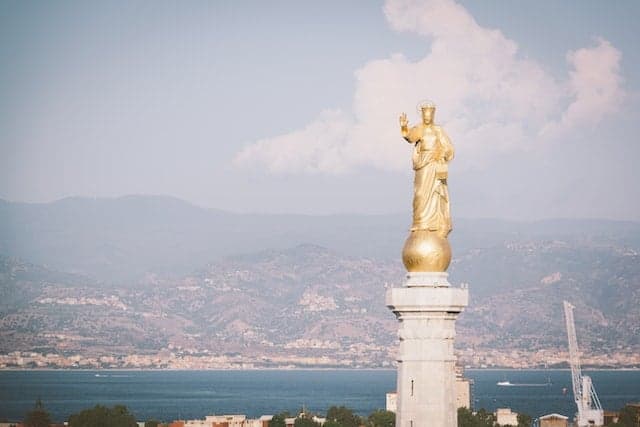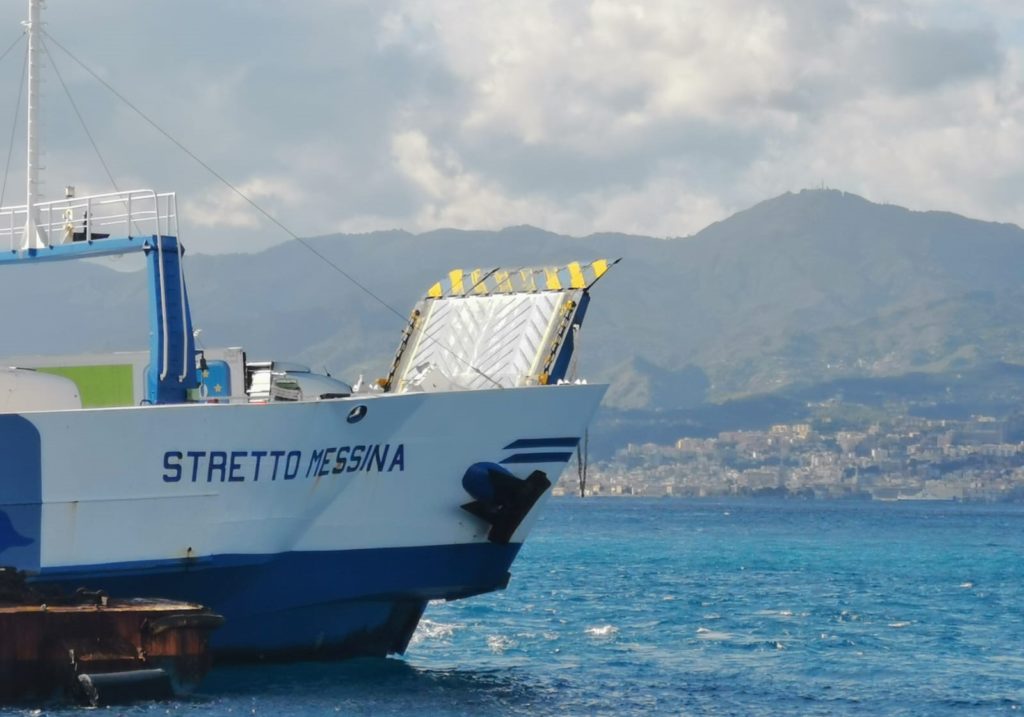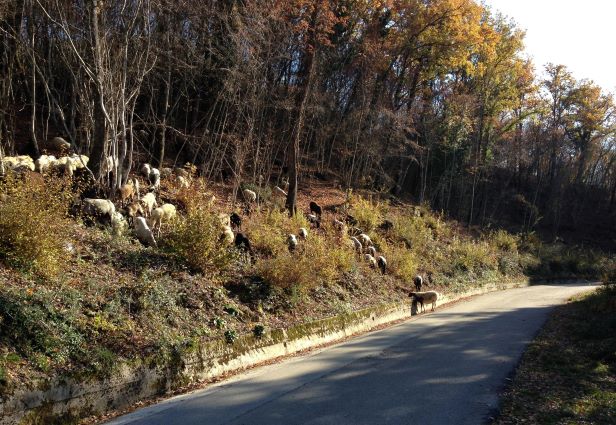Costly flights, few trains: What’s travel like between Sicily and mainland Italy?

Sicily may be just a stone’s throw from mainland Italy but getting there and back is not always simple or fast, as Silvia Marchetti explains.
Transport connections between Italy’s largest island region and the main Italian cities are expected to improve in the long run, with the government hoping to use European pandemic recovery funds. But infrastructure investments take years to bear fruit.
Taking a flight is of course the easiest and quickest way to reach Sicily, where there are three main airports - Palermo, Catania, Trapani - plus two minor ones on the southernmost Pantelleria and Lampedusa islands. But there are mounting ticket costs.
The recent investigation launched by Italian authorities into alleged price-fixing on flights to and from Sicily during Christmas holidays by many low-cost airlines shows how fliers might have been left with little choice. Unless one is an island resident with access to privileged fares, the round trip is often costly.
I recently did an online search and found flights to Sicily are still quite expensive, costing roughly 300 euros for a return trip from Rome, even if booked well in advance. And not all Italian airports serve the destination.
READ ALSO: Trains and planes: Italy’s new international travel routes in 2023
Paradoxically, it is often easier to reach Sicily from a European city such as London or Brussels than from an Italian one, and I often envy foreign friends who quickly find a much cheaper flight than I can from Rome. Others hop on ferry boats in southern France to land in Sicily.
For those already in Italy, other options are traveling by train or car, which can still be hellish. Even though the A1 autostrada del Sole, the country’s backbone, has been completed, driving down the length of the country takes 12 hours - inclusive of meal and toilet stops - roughly 1,500 kilometers. I did it once, and it is crazy, but it depends on how much one loves driving.
All train connections end in Reggio Calabria or other southern regions, even the high-speed Italo takes 10 hours from Milan to the tip of the boot. The journey by train is less stressful than by car or plane, and costs roughly 280 euros for a round trip from Milan.
Travel to and from Sicily can often turn into a nightmarish odyssey. I’ve spoken to lots of Sicilians and foreigners who often embark on a 24-hour trip to get to Sicily from Rome and Milan.
I remember once going to Linosa island for the summer holidays and having to take the plane to Palermo, then a long bus ride to Porto Empedocle to catch the midnight ferry, sleeping on a bench and waking up the next morning to stunning volcanic black scenery. I could have taken the plane to sister-isle Lampedusa and then a quick ferry boat, but the air fare was way over my budget. That trip lasted 28 hours, exactly the same amount of time as my past flights to Jakarta from Rome - but with added stress.

The ferry connecting Messina, Sicily with Villa San Giovanni, Calabria. Photo: Clare Speak/The Local
The government aims to revive the Messina bridge plan, an idea which has been floating in the air since 1866. I doubt things would change much. Many people would still drive their cars along the bridge rather than take the ecological high speed railway expected to be built on it.
To improve connections, transport must shift from the road to the railway tracks by increasing high-speed train services, as well as ferries, thus curbing CO2 emissions. High-speed sea connections to and from Naples, Civitavecchia, Livorno and other key mainland ports should also be increased.
READ ALSO: Yes, train travel across Europe is far better than flying – even with kids
The Messina bridge, which I seriously doubt will be built during this government’s five-year legislature, would just end up increasing road traffic. Locals and tourists in Calabria will be tempted to drive their car or motorino just three kilometers to grab a cassata cake in Messina.
However, the real issue is not getting to and from Sicily, but getting around Sicily once you land there.
I had the chance to meet several Sicilian commuters who travel almost daily from a rural village to Rome, Naples or Milan for meetings. They wake up at three in the morning and return home at 11pm, up to four times a week.
Island train and bus connections are rather poor so the car is their best option to get to the airport. However, bar the main highways, most Sicilian roads are a work-in-progress or in bad condition.

You never know where a Sicilian road trip might take you. Photo: Silvia Marchetti
I happened to experience an ‘adventurous’ road trip once from Catania airport to a tiny village in the province of Caltanissetta. According to the satellite map it was meant to take roughly two hours, but it turned out to be five, and I literally found myself in the middle of the countryside surrounded by sheep and ravines. Not quite the idyll I had dreamt.
Some highways were shut due to maintenance so I had to cut across unpaved rural roads without street lights, or deviate elsewhere which lengthened my trip (ravenous, I took five minutes to stop for a quick cannolo on the way).
It all depends on what degree of adventure travelers are seeking. Distances seem shorter for some foreigners than they do to Italians. Americans in particular and others from non-European Union countries are excited to drive from Milan to Sicily, for they can catch a glimpse of Italy in its entirety, or tour Sicily’s main archaeological sites in eight hours.
But many others I know, because of the poor state of Sicilian roads and regional connections, prefer to fly in and rent cars with drivers to take them to their destinations.
The future of Sicily’s transport connections must be affordable and more frequent flights, high-speed railways and eco-friendly boats. Not new bridges and even more cars on the road.
Comments (1)
See Also
Transport connections between Italy’s largest island region and the main Italian cities are expected to improve in the long run, with the government hoping to use European pandemic recovery funds. But infrastructure investments take years to bear fruit.
Taking a flight is of course the easiest and quickest way to reach Sicily, where there are three main airports - Palermo, Catania, Trapani - plus two minor ones on the southernmost Pantelleria and Lampedusa islands. But there are mounting ticket costs.
The recent investigation launched by Italian authorities into alleged price-fixing on flights to and from Sicily during Christmas holidays by many low-cost airlines shows how fliers might have been left with little choice. Unless one is an island resident with access to privileged fares, the round trip is often costly.
I recently did an online search and found flights to Sicily are still quite expensive, costing roughly 300 euros for a return trip from Rome, even if booked well in advance. And not all Italian airports serve the destination.
READ ALSO: Trains and planes: Italy’s new international travel routes in 2023
Paradoxically, it is often easier to reach Sicily from a European city such as London or Brussels than from an Italian one, and I often envy foreign friends who quickly find a much cheaper flight than I can from Rome. Others hop on ferry boats in southern France to land in Sicily.
For those already in Italy, other options are traveling by train or car, which can still be hellish. Even though the A1 autostrada del Sole, the country’s backbone, has been completed, driving down the length of the country takes 12 hours - inclusive of meal and toilet stops - roughly 1,500 kilometers. I did it once, and it is crazy, but it depends on how much one loves driving.
All train connections end in Reggio Calabria or other southern regions, even the high-speed Italo takes 10 hours from Milan to the tip of the boot. The journey by train is less stressful than by car or plane, and costs roughly 280 euros for a round trip from Milan.
Travel to and from Sicily can often turn into a nightmarish odyssey. I’ve spoken to lots of Sicilians and foreigners who often embark on a 24-hour trip to get to Sicily from Rome and Milan.
I remember once going to Linosa island for the summer holidays and having to take the plane to Palermo, then a long bus ride to Porto Empedocle to catch the midnight ferry, sleeping on a bench and waking up the next morning to stunning volcanic black scenery. I could have taken the plane to sister-isle Lampedusa and then a quick ferry boat, but the air fare was way over my budget. That trip lasted 28 hours, exactly the same amount of time as my past flights to Jakarta from Rome - but with added stress.

The government aims to revive the Messina bridge plan, an idea which has been floating in the air since 1866. I doubt things would change much. Many people would still drive their cars along the bridge rather than take the ecological high speed railway expected to be built on it.
To improve connections, transport must shift from the road to the railway tracks by increasing high-speed train services, as well as ferries, thus curbing CO2 emissions. High-speed sea connections to and from Naples, Civitavecchia, Livorno and other key mainland ports should also be increased.
READ ALSO: Yes, train travel across Europe is far better than flying – even with kids
The Messina bridge, which I seriously doubt will be built during this government’s five-year legislature, would just end up increasing road traffic. Locals and tourists in Calabria will be tempted to drive their car or motorino just three kilometers to grab a cassata cake in Messina.
However, the real issue is not getting to and from Sicily, but getting around Sicily once you land there.
I had the chance to meet several Sicilian commuters who travel almost daily from a rural village to Rome, Naples or Milan for meetings. They wake up at three in the morning and return home at 11pm, up to four times a week.
Island train and bus connections are rather poor so the car is their best option to get to the airport. However, bar the main highways, most Sicilian roads are a work-in-progress or in bad condition.

I happened to experience an ‘adventurous’ road trip once from Catania airport to a tiny village in the province of Caltanissetta. According to the satellite map it was meant to take roughly two hours, but it turned out to be five, and I literally found myself in the middle of the countryside surrounded by sheep and ravines. Not quite the idyll I had dreamt.
Some highways were shut due to maintenance so I had to cut across unpaved rural roads without street lights, or deviate elsewhere which lengthened my trip (ravenous, I took five minutes to stop for a quick cannolo on the way).
It all depends on what degree of adventure travelers are seeking. Distances seem shorter for some foreigners than they do to Italians. Americans in particular and others from non-European Union countries are excited to drive from Milan to Sicily, for they can catch a glimpse of Italy in its entirety, or tour Sicily’s main archaeological sites in eight hours.
But many others I know, because of the poor state of Sicilian roads and regional connections, prefer to fly in and rent cars with drivers to take them to their destinations.
The future of Sicily’s transport connections must be affordable and more frequent flights, high-speed railways and eco-friendly boats. Not new bridges and even more cars on the road.
Join the conversation in our comments section below. Share your own views and experience and if you have a question or suggestion for our journalists then email us at [email protected].
Please keep comments civil, constructive and on topic – and make sure to read our terms of use before getting involved.
Please log in here to leave a comment.